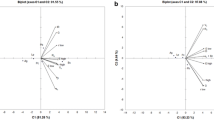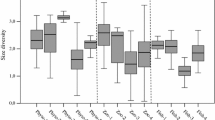Synopsis
Choice of the apparently largest prey has been implicated as an important component of the size choice behavior of several planktivorous fish species. In this study we describe the effect of several aspects of prey placement, apparent and absolute size, and motion on the choice behavior of bluegill or white crappie. In binary choice experiments, bluegill usually choose Daphnia prey on the basis of apparent size. However, when both prey were close to the fish and the absolutely larger prey was apparently smaller, the fish commonly chose the absolutely larger. The horizontal placement of two prey also altered choice such that the more forward directed prey was chosen even when apparently smaller. White crappie, when offered a choice between a diaptomid copepod or daphnid prey, chose the daphnid most of the time. Bluegill sunfish offered moving versus non-moving heat-killed daphnids commonly chose the one in motion. Apparent size choice is still a good overall describer of bluegill and white crappie prey choice, but it is not the only mechanism involved in prey choice behavior of these fish.
Similar content being viewed by others
References cited
Boulet, P.C. 1958. Contibution a l'etude experimentale de la perception visuelle du mouvement chez la perche et la seiche. Mem. Mus. Natl. Hist. Nat., Paris, Ser. A. Zool. 17. 131 pp.
Confer, J.L. & P.I. Blades. 1975. Omnivorous zooplankton and planktivorous fish. Limnol. Oceanogr. 20: 571–579.
Eggers, D.M. 1977. The nature of prey selection by planktivorous fish. Ecology 58: 46–59.
Eggers, D.M. 1982. Planktivore preference by prey size. Ecology 63: 381–390.
Gibson, R.M. 1980. Optimal prey-size selection by three-spined sticklebacks (Gasterosteus aculeatus): a test of the apparentsize hypothesis. Z. Tierpsychol. 52: 291–307.
Hairston, N.G., Jr., K.T. Li & S.S. Easter, Jr. 1982. Fish vision and the detection of planktonic prey. Science 218: 1240–1242.
Keast, A. 1978. Feeding interrelations between age-groups of pumpkinseed (Lepomis gibbosus) and comparisons with bluegill (L. macrochirus). J. Fish. Res. Board Can. 35: 12–27.
Kerfoot, W.C. 1982. A question of taste: crypsis and warning coloration in freshwater zooplankton communities. Ecology 63: 538–554.
Kislalioglu, M. & R.N. Gibson. 1976. Some factors governing prey selection by the fifteen-spined stickleback, Spinachia Spinachia (L.). J. Exp. Mar. Biol. Ecol. 25: 159–169.
Mellors, W.K. 1975. Selective predation of ephippial Daphnia and the resistance of ephippial eggs to digestion. Ecology 56: 974–980.
O'Brien, W.J., N.A. Slade & G.L. Vinyard. 1976. Apparent size as the determinant of prey selection by bluegill sunfish (Lepomis macrochirus). Ecology 57: 1304–1310.
Siegel, S. 1956. Nonparametric statistics for the behavioral sciences. McGraw-Hill, New York. 312 pp.
Vinyard, G.L. 1980. Differential prey vulnerability and predator selectivity: effects of evasive prey on bluegill (Lepomis macrochirus) and pumpkinseed (L. gibbosus) predation. Can. J. Fish. Aquat. Sci. 37: 2294–2299.
Vinyard, G.L. & W.J. O'Brien. 1976. Effects of light and turbidity on the reactive distance of bluegill sunfish (Lepomis macrochirus). J. Fish. Res. Board Can. 33: 2845–2849.
Ware, D.M. 1973. Risk of epibenthic prey to predation by rainbow trout (Salmo gairdneri). J. Fish. Res. Board Can. 30: 787–797.
Werner, E.E. & D.J. Hall. 1974. Optimal foraging and the size selection of prey by the bluegill sunfish (Lepomis macrochirus). Ecology 55: 1042–1052.
Wetterer, J.K. & C.J. Bishop. 1984. Planktivore prey selection: the reactive field volume model versus the apparent size model. Ecology (in print).
Wright, D.I. 1981. The planktivorous feeding behavior of white crappie (Pomoxis annularis): field testing a mechanistic model. Ph.D. Thesis, University of Kansas, Lawrence. 116 pp.
Wright, D.I. & W.J. O'Brien. 1982. Differential location of Chaoborus larvae and Daphnia by fish: the importance of motion and visible size. Amer. Midl. Nat. 108: 68–73.
Wright, D.I. & W.J. O'Brien. 1984. The development and field test of a tactical model of the planktivorous feeding of white crappie (Pomoxis annularis). Ecol. Monogr. 54: 65–98.
Zaret, T.M. 1972. Predator-prey interaction in a tropical lacustrine ecosystem. Ecology 53: 248–257.
Zaret, T.M. 1980. The effect of prey motion on planktivore choice. pp. 594–603. In: W.C. Kerfoot (ed.) Evolution and Ecology of Zooplankton Communities, University Press of New England, Hanover.
Zaret, T.M. 1981. Predation and freshwater communities. Yale University Press, New Haven. 187 pp.
Zaret, T.M. & W.C. Kerfoot. 1975. Fish predation on Bosmina longirostris: body-size selection versus visibility selection. Ecology 56: 232–237.
Author information
Authors and Affiliations
Rights and permissions
About this article
Cite this article
John O'Brien, W.J.O., Evans, B. & Luecke, C. Apparent size choice of zooplankton by planktivorous sunfish: exceptions to the rule. Environ Biol Fish 13, 225–233 (1985). https://doi.org/10.1007/BF00000934
Received:
Accepted:
Issue Date:
DOI: https://doi.org/10.1007/BF00000934




